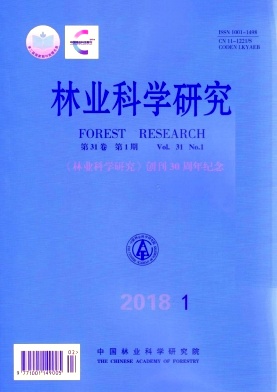-
在全球应对气候变化的大背景下,由于森林在全球碳循环中发挥着重要作用,森林生物量和碳储量越来越受到世界各国的广泛关注。通常所说的森林生物量主要指森林植被生物量,一般不包括土壤有机质。而森林植被生物量中乔木林生物量占主体,目前各国建立的生物量模型指的也是乔木树种[1-3]。
关于森林生物量的估计,国外最早可以追溯到19世纪70年代,而我国基本上是从本世纪初才开始的[4-7]。2001年方精云等提出了转换因子连续函数法[8],该方法在国内外的影响都比较大。在2003和2006年IPCC发布的两份指南中,提出了基于材积源的生物量和碳储量通用估计方法[9-10],该方法的局限性主要在于各个参数的可获性。近10年来,国内外有诸多学者对不同的生物量和碳储量估计方法进行了对比分析[11-14],Zhou和Hemstrom在美国俄勒冈州对国家级模型、区域模型和组成比值法(CRM)3种估计方法作了对比分析[11],认为国家级模型并不适合中小尺度的生物量估计;李海奎等[12]比较了IPCC的通用方法、方精云的转换因子连续函数法和生物量回归模型法,认为方法3的精度最高;Gao等[13]对4种碳储量评估方法进行了对比,认为直接采用碳储量回归模型效果最好,而采用0.5的通用系数效果最差;Tang等[14]基于森林清查资料对5种生物量估计方法作了对比,其中也包括IPCC法和转换因子连续函数法,但其对比基础只是一个县的数据。现有研究结果表明生物量回归模型法是最好的,但对转换因子连续函数法的效果评价不一。
近年来,我国在立木生物量回归模型研建方面取得了不少成果[3-4, 15-16],并颁布实施了一系列树种的立木生物量模型及碳计量参数行业标准[17-22]。为了进一步比较不同估计方法的优劣,本研究以广东省森林资源连续清查的杉木(Cunninghamia lanceolata (Lamb.) Hook.)和马尾松(Pinus massoniana Lamb.)2个主要森林类型的调查数据为基础,结合在森林资源清查中的实际应用需求,同时对不同生物量和碳储量的估计方法进行对比分析,并重点对不同的回归模型估计方法及估计效果进行对比,对转换因子连续函数法的适用性进行分析,以期为确定在国家森林资源清查中生物量和碳储量的具体估计方法提供依据。
HTML
-
本文所用数据来自第八次全国森林资源清查2012年广东省清查,包括180个样地的14 293株样木,每个样地的样木不少于30株,样地面积为667 m2。其中,优势树种为杉木的样地100个,样木9 117株,其中杉木占87%;优势树种为马尾松的样地80个,样木5 176株,其中马尾松占76%。样地的基本情况见表 1。
树种
Species统计指标
Statistics平均胸径
Mean diameter/cm平均树高
Mean height/m平均年龄
Mean age/a郁闭度
Closure蓄积
Volume/(m3·hm-2)杉木Chinese fir 平均值Mean 11.2 9.1 17 0.60 66.4 最小值Min 6.5 4.0 4 0.20 5.2 最大值Max 28.8 17.1 41 0.90 214.0 马尾松Masson pine 平均值Mean 14.4 10.1 24 0.54 69.1 最小值Min 7.5 4.1 9 0.30 9.2 最大值Max 24.7 19.0 53 0.88 282.2 Table 1. Statistics of main stand attributes of the sample plots
-
关于生物量的估计,IPCC提供了一个通用的方法,其计算公式为[9-10]:
式中,M为总生物量,V为树干材积,d为树干密度,BEF为生物量扩展因子,R为根茎比(地下生物量与地上生物量之比)。基于(1)式的材积源计算方法,既可适用于从宏观到微观的不同尺度,还可保证生物量与蓄积量之间的协调性,因而广受推崇。尽管IPCC提供了用于大尺度估计的参数,但这些参数用于中小尺度时往往会产生较大偏差。因此,各国应用该方法时,必须建立适用于自己国家的参数体系。近年来,国家林业局相继颁布实施了一系列树种(组)的《立木生物量模型及碳计量参数》行业标准[17-22],为准确估计森林生物量和碳储量奠定了科学基础。
-
在《立木生物量模型及碳计量参数》系列行业标准中,生物量扩展因子BEF和树干密度d被合为一个参数,即生物量转换因子BCF(在IPCC 2006年的指南中称为生物量转换与扩展因子BCEF)。因此,(1)式变为:
式中,BCF和R不是固定常数,而是可变函数。基于(2)式的方法称为生物量转换因子法或改进IPCC法(方法A)。另外,系列行业标准也提供了估计立木地上和地下生物量的模型。直接基于生物量模型进行估计的方法,称为生物量模型法(方法B)。生物量转换因子模型、根茎比模型及地上和地下生物量模型均包括基于胸径的一元模型及基于胸径和树高的二元模型两套。如(2)式中的BCF可表示为:
式中,D、H分别为林木的胸径和树高,a1、b1为一元模型参数,a2、b2、c2为二元模型参数。因此,方法A、B又各有1、2两套方案。第2套方案涉及二元模型的应用,本研究根据每个样地的平均胸径、平均树高和每木检尺胸径D,利用叶金盛[23]建立的相对树高曲线模型,得出样地上每株样木的树高H,然后基于样木的D、H,用相应的二元模型计算材积V及生物量M。
为了进一步检验方精云等提出的生物量转换因子函数是否适用,本研究采用其21个森林类型中的杉木和马尾松2个模型,基于样地蓄积量来估计每个样地的生物量,该法称为转换因子连续函数法或方精云法(方法C)[8, 12, 14]。按样地蓄积量来自一元模型或二元模型,也有1、2两套方案。
-
碳储量取决于生物量和含碳系数的大小。含碳系数相对比较稳定,在早期的很多文献中都取0.5的值[8, 24-25]。在IPCC2003年提供的指南中,含碳系数也是采用0.5[9];但在IPCC2006年的国家温室气体清单指南中,含碳系数又调整为0.47[10]。在《立木生物量模型及碳计量参数》系列行业标准中,每个树种(组)都分别全树、地上、地下、树干、树皮、树枝、树叶生物量提供了含碳系数[17-22]。本研究采用3种方法进行计算:一是平均含碳系数法,即基于每个树种(组)的全树生物量平均含碳系数计算;二是组分含碳系数法,是指分别每个树种(组)的地上和地下生物量含碳系数计算;三是固定含碳系数法,即采用通常的缺省值0.5或0.47计算。最后根据计算结果进行对比,分析其差异大小。
1.1. 数据资料
1.2. 估计方法
1.2.1. 生物量估计方法
1.2.2. 碳储量估计方法
-
利用广东省2012年森林资源连续清查的180个样地的每木检尺数据(含树种、胸径、一元材积),分别采用生物量转换因子法(改进IPCC法)、生物量模型法和转换因子连续函数法(方精云法)3种方法(A、B、C)共6套方案,计算杉木和马尾松两个优势树种林分的生物量。由于这些样地只是从全部样地中按活立木株数不少于30株的条件挑选出来的,不构成推算总体的代表性样本,因此其结果仅针对样地。表 2为不同生物量估计方法的对比结果。
树种
Species生物量
Biomass改进IPCC法
Improved IPCC method生物量模型法
Biomass model method方精云法
Fang’s methodA1 A2 B1 B2 C1 C2 杉木Chinese fir 总生物量Total biomass/Mg 281.8 308.4 322.9 319.9 2 431.1 2 446.5 地上生物量Aboveground biomass/Mg 229.0 249.7 262.5 259.2 / / 地下生物量Belowground biomass/Mg 52.8 58.7 60.4 60.7 / / 马尾松Masson pine 总生物量Total biomass/Mg 266.2 303.1 351.7 331.2 271.5 283.7 地上生物量Aboveground biomass/Mg 221.6 249.2 293.6 272.4 / / 地下生物量Belowground biomass/Mg 44.6 53.9 58.1 58.8 / / 注:方案1指基于一元模型,方案2指基于二元模型。
Note: Scheme 1 is based one-variable model, and scheme 2 is based two-variable model.Table 2. Comparison of results from different methods for estimating biomass
从各种方法本身的特性考虑,3种方法6套方案中应该以B2(即基于二元模型的生物量模型法)得出的结果最为准确。B1与B2得出的结果相比,杉木的总生物量和地上、地下生物量仅分别相差0.9%、1.3%和-0.5%,但马尾松则分别相差6.2%、7.8%和-1.0%。经分析,其原因主要是胸径-树高模型的差异造成的。行业标准中一元、二元模型所隐含的胸径-树高相关模型,与100个杉木林样地的胸径-树高模型相差不大,但与80个马尾松林样地的胸径-树高模型相比,其树高估计值要显著偏高。
A2与B2得出的结果相比,杉木和马尾松的总生物量分别相差-3.6%和-8.5%。经分析,其原因主要是现行二元立木材积表存在偏低估计造成的[26]。A1与B2得出的结果相比,杉木和马尾松的总生物量分别相差-11.9%和-19.6%。其原因除了二元立木材积表存在偏低估计外,还因为一元表与二元表之间存在差异。根据分析,广东森林资源清查中所采用的杉木和马尾松一元材积表的估计值,均要低于二元材积表的估计值。对于基于材积的生物量转换因子法(A1和A2),材积估计的误差相应地也会带到生物量的估计中。如果材积估计值偏低,其生物量估计值也会偏低,以此保证生物量与蓄积量之间的协调性。
再来看转换因子连续函数法的结果。杉木的C1与C2估计结果几乎比前面两种估计方法的结果要大一个数量级,与B2的估计结果相比分别大6.60和6.65倍!我们反复核对了文献上的模型参数,确认无误,至于为何会相差这么大,其原因不得而知。而马尾松的C1与C2估计结果,与B2的估计结果相比相差-18.0%和-14.3%,介于A1和A2的估计结果之间。
-
碳储量估计是在生物量估计的基础上进行的,目的是要对比3种方法估计结果的差异。因为与生物量估计方法无关,故没有对前述6个生物量计算方案计算18套碳储量结果,而只针对改进IPCC法A1和A2两套方案的生物量估计结果,按3种不同的碳储量估计方法进行计算。表 3为不同碳储量估计方法的对比结果。
树种
Species生物量估计方法
Biomass estimation method平均含碳系数法
Mean carbon content method/Mg组分含碳系数法
Component carbon content method/Mg固定含碳系数法
Constant carbon content method/Mg0.5 0.47 杉木Chinese fir A1 140.2 140.0 140.9 132.4 A2 153.5 153.2 154.2 144.9 马尾松Masson pine A1 137.8 137.3 133.1 125.1 A2 157.1 156.4 151.5 142.5 Table 3. Comparison of results from different methods for estimating carbon storage
从表 3可以看出,不论生物量估计方法是A1还是A2,按平均含碳系数法的计算结果与按组分含碳系数的计算结果相比差异很小,其中杉木林仅相差0.2%,马尾松林相差约0.4%。而按固定含碳系数法计算,杉木林取0.5时比较接近,碳储量估计值仅相差0.6%,取0.47则低估5.4%;马尾松林则2种固定含碳系数都要低估,其中取0.5时要低估3.3%,取0.47时要低估9.1%。
2.1. 生物量估计结果
2.2. 碳储量估计结果
-
根据Zhou和Hemstrom[11]在美国俄勒冈州的研究结论,国家级生物量模型(Jenkins模型)用于区域范围时会产生较大误差,因此认为它们并不适合中小尺度的生物量估计。李海奎等的研究结论是,IPCC法更像是一个标准,可以通过适当的变换,在较大的范围内使用;方精云的转换因子连续函数法,因为是有明确参数的具体模型,对较小使用范围(比如省级)可能并不适宜;而生物量模型法,一般是基于立木水平的模型,其精度是最高的[12]。Tang等[14]的研究结果反映出转换因子连续函数法对不同树种的生物量估计值差异较大。本研究以近年来我国建立的主要树种立木生物量模型为基础,将IPCC法的固定参数改进为可变参数,对改进IPCC法、生物量模型法和转换因子连续函数法(方精云法)3种方法按一元和二元模型共6种方案进行了对比分析。因为方精云法所采用的模型属于林分水平模型,其估计精度一般要低于立木水平的模型。本研究的研究结果再一次证实了这一基本论断。特别是方精云法对于杉木林生物量的估计结果,比正常估计结果相差了一个数量级,说明其适用性很差。
根据Gao等[13]对碳储量评估方法得出的结论,直接采用碳储量回归模型的效果是最好的,而间接采用生物量模型再乘以样木的平均含碳系数或样木各组分的平均含碳系数,其结果与直接采用碳储量回归模型都相差不大,但如果含碳系数采用0.5,其效果是最差的。本研究基于IPCC的通则,没有建立碳储量回归模型,而是基于一元或二元生物量模型的估计值,再用平均含碳系数、组分含碳系数或固定含碳系数进行计算,其结果与Gao等的结论类似。采用固定含碳系数0.5或0.47之所以产生较大误差,是因为不同树种的含碳系数存在差异[17-22]。譬如,杉木生物量的平均含碳系数为0.499,而马尾松为0.525。很显然,将0.5的含碳系数用于杉木差异很小,用0.47差异就大了;而对于马尾松,则不管是采用0.5还是0.47的含碳系数,差异都会比较大。
-
综合前述分析,可以得出以下结论:对生物量的估计,采用生物量模型法准确性最高,而林木水平的生物量模型其预估精度要高于林分水平的模型;方精云法只是基于IPCC法所建立的林分水平模型在宏观层面上的一种具体应用方法,其精度要低于林木水平的生物量模型法,不适于中小尺度应用;IPCC法是基于材积源的通用方法,将生物量扩展因子BEF或生物量转换因子BCF和根茎比R从缺省参数改进为可变参数模型,可大大提高方法的适应性;不论是生物量模型还是生物量转换因子模型,二元模型的预估精度要高于一元模型,其适用范围和应用尺度更广;对碳储量的估计,采用平均含碳系数法或组分含碳系数法差异很小,但采用固定含碳系数法则误差较大。
基于以上结论,提出如下几点建议:为保证生物量与蓄积量估计结果的协同性,在国家森林资源清查中对生物量的估计,应采用相容性立木生物量转换因子模型而不是直接采用生物量模型;为保证蓄积量及生物量和碳储量估计结果的准确性,应该对目前所有的一元材积模型及最基础的二元材积模型进行适用性检验,对不再适用的应及时予以修正;鉴于目前各省对森林蓄积量的估计均是基于一元材积模型,生物量的估计也应该采用相应的一元模型;碳储量的估计可分别树种(组)用生物量乘以平均含碳系数进行计算。





 DownLoad:
DownLoad: